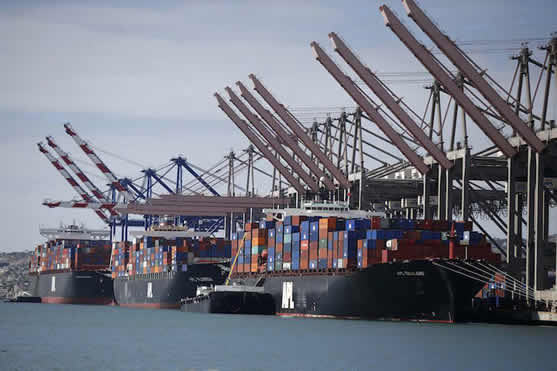APM Terminals’ Head of Design and Automation, Alex Duca addressed the Port Equipment Manufacturers Association’s (PEMA) annual meeting on Wednesday, introducing the company’s “Terminal Eco-System” concept as part of an object-oriented approach to terminal design, construction and operation.
“We are rethinking equipment design and manufacturing protocols as a way of enhancing productivity as well as improving port equipment operators’ lives and workspaces”, said Mr. Duca, who cited the integration of automation and control systems to improve productivity as well as safety performance in terminal facilities.
By looking at a container terminal within the context of a self-contained, holistic, “eco-system” of interdependent functions and needs, improvements in machinery and procedures can be designed into the system, often by adapting very basic changes already evident in other industries, Duca advised the PEMA conference audience.
PEMA was established by a group of leading equipment manufacturers serving the global port and terminal markets in 2004 to create a neutral platform to publicly represent the industry, as well as fostering enhanced knowledge and relations within the global port equipment community. During the intervening decade, global container throughput has more than doubled from just over 300 million TEUs to approximately 700 million TEUs annually, transforming global trade, and the global economy, and creating a more demanding environment for participants within the global port industry.
In his presentation, Duca identified five challenges that the port industry must successfully confront to meet the requirements of the evolving global logistics chain:
· Safety performance on par- or better than other industries;
· Larger scale of operational complexity as vessel sizes surpassing capacities of 20,000 TEUs become reality;
· Limits to terminal space availability for expansion and the risk of congestion;
· Maintaining profitability through economic cycles affecting shipping lines; and
· Maximization of returns on terminal asset management.
“We have to do more with less space every year” Duca observed, mentioning a Maersk EEE class vessel which loaded an industry-record 18,168 TEUs last week at the APM Terminals-operated facility at the Port of Algeciras, Spain. The need for asset management was illustrated by the scope of the equipment currently in use throughout the APM Terminals Global Terminal Network, at APM Terminals Algeciras and elsewhere, including over 500 quay cranes and mobile harbor cranes, 1,700 pieces of container yard lifting equipment (RTGs, reach stackers and empty handlers), and approximately 3,000 terminal trucks.
Duca listed significant new innovations which can be integrated into to the port equipment manufacturing industry, such as “Google glass”-type windshields and sensors that could provide better safety visibility and awareness around port machinery for drivers. These next-generation machines, specifically designed to interface directly with Terminal Operating Systems, and with other cargo handling equipment and even with waiting truck drivers, could have a major impact on safety and productivity.
Applying new technology to existing equipment is also possible, but Duca pointed out that there are obstacles due to the way the equipment manufacturers pursue proprietary standards. This is noticeable with crane retro-fitting in particular, as terminals invest to accommodate Ultra-Large Container Ships which require taller gantries and a wider reach.
“Crane enhancements are hampered by proprietary control systems that make wider roll-out of modular retro-fit packages excessively complex” stated Duca, adding, “there is a vast opportunity to improve equipment positioning and container location services as well through increased standardization”.
Duca praised the automobile and jet engine manufacturing industries which have had success in such standardization, to the benefit of all parties, as well as the end-users, with innovative technology such as use of more sensors, better diagnostics through data and shared platforms.
Said Duca, “Let me challenge you today to bring the cargo-handling equipment manufacturing process and features up to the speed of the car industry and jet engine industry; let’s create a world-class “Terminal Eco-System” to meet the challenges of an exciting and evolving port industry to help make our people on the front line safer and our customers profitable”.
Copyright Ships & Ports Ltd. Permission to use quotations from this article is granted subject to appropriate credit given to www.shipsandports.com.ng as the source.

